Monday, December 20, 2004

International Perspective is taking Christmas weekend off.
The next IP will be available on January 3, 2005.
Econoday wishes you all a happy holiday season.
The Federal Reserve's 25-basis-point Fed funds rate increase to 2.25 percent passed almost unnoticed by the financial markets, so sure were market participants of the FOMC's meeting result. But the FOMC did offer a surprise, announcing it would begin releasing minutes three weeks after meetings instead of six weeks. This means that policy nuances will be available for parsing to Fed watchers sooner - and importantly prior to the next meeting. Minutes have been available only after a subsequent meeting making them virtually useless in policy analysis (although everyone read them anyhow). The action places the Fed funds rate 25 basis points higher than the European Central Bank's policy rate of 2 percent but still lower than the rates of the Bank of Canada and Bank of England.
The Dow and Nikkei continue to be the worst performers in 2004. The graph below shows that the Dow and Nikkei are 1.8 percent and 3.8 percent respectively over their 2003 year end value. The FTSE and DAX have managed to gain about 4.9 to 5.5 percent respectively. Note how the Canadian and Australian indexes have soared above all, gaining 11 percent and 20.9 percent. On the week, only the CAC lost ground.

Global Stock Market Recap

Europe and Britain
With the last full week of trading for most completed, the FTSE, CAC and DAX were up on the week - at least until Thursday. Proposed mergers buoyed investors. But this optimism was more than offset on Friday when pharmaceutical companies sank on more bad news relating to specific drugs. AstraZeneca Plc tumbled after its lung cancer treatment failed to help patients live longer and after Pfizer, the world's biggest drug company, said a study unexpectedly showed Celebrex to increase cardiovascular risk. The study raised further safety questions about an entire class of painkilling drugs. Pharmaceutical stocks generally react strongly to news, be it positive or negative, and Friday was no exception. When the dust settled on Friday, the FTSE and DAX still managed to eke out a gain on the week, but the CAC did not.

Merger and acquisitions activity was sparked by the bid for the London Stock Exchange. The LSE received a bid (and turned it down but said they would talk) from Deutsche B�rse. Werner Seifert, chief executive of Deutsche B�rse, has sought to reassure the London Stock Exchange that his interest in acquiring the rival exchange is not a hostile bid and that he is amenable to negotiation on all aspects of an agreement. Paris-based Euronext is a probable rival bidder for the LSE. Euronext is thought to have engaged investment banks to advise it on a prospective bid for the LSE. Seifert is understood to have hinted that the combined LSE-Deutsche B�rse business might have its headquarters in London, in a move to reassure the exchange's investment banking customer base. However, details were scant on clearing and settlement arrangements, which are emerging as the single most contentious issue for the LSE's investment banking customers who say it may raise competition issues.
During the week, auto stocks were boosted after car sales in the region increased last month, as new models and rebates attracted buyers. Germany's benchmark DAX Index climbed to a 29-month high during the week on the news. Car sales rose to 1.14 million vehicles from 1.04 million units a year earlier, the Brussels-based European Automobile Manufacturers Association said. Sales in the first 11 months were up 1.7 percent to 13.5 million vehicles. But one day's gains became the next day's losses. European technology stocks including Ericsson AB and carmakers such as DaimlerChrysler AG fell after oil had its biggest gain in six months, raising concern higher energy costs may erode corporate profit growth.
Asia/Pacific
All six Asia/Pacific indexes followed here burnished their 2004 records and were up last week. The Australian all ordinaries continued to climb to new record heights, now threatening at year end to break the 4,000 level for the first time. Of the six regional indexes followed here, the index is outpacing the Singapore STI for best performer of the year.

Japanese indexes were up as the Tankan survey managed to do better than expected by analysts. (See indicator scoreboard below.) Thus far, the Nikkei is trailing other Asian stock indexes followed here. On Thursday, Japanese stocks fell after the dollar slumped against the yen and oil prices surged, renewing concern that slowing U.S. demand and higher fuel costs will dent economic growth. Shares of exporters such as Honda Motor declined. Stocks also dropped after Japan's ruling coalition agreed to end income and residential tax breaks in the next two years, reducing the amount consumers have to spend. But stocks rebounded on Friday, pushing the Nikkei over the 11,000 mark for the first time since mid-November as positive U.S. data boosted investor confidence - especially for exporters - after jobless claims and manufacturing reports eased concern that U.S. demand would slow. As many an analyst has said - any piece of positive news from the U.S. makes exporters' stocks look attractive.

Currencies
The dollar bobbed and weaved through the week but traded in relatively narrow ranges against the euro and the yen. The dollar traded in a range between $1.325 to $1.34 against the euro, while against the yen, it hovered near 104.5 yen. The yen was up on Friday after Bank of Japan Governor Toshihiko Fukui said the economy will keep expanding and as Japanese stocks were up on the day. Fukui said the economy is currently on a plateau, a situation he expects to continue in 2005.

With the meatiest U.S. data for December out of the way, the market is rapidly entering holiday mode, with traders making last adjustments to positions in preparation for the new year. Also, there was the feeling that the bulk of the bad news for the dollar was over, with a fresh slate of range-bound trading action anticipated until January's employment and trade flow releases offer new insight into 2005 direction.
Indicator scoreboard
EMU - November harmonized index of consumer prices was down 0.1 percent but up 2.2 percent when compared with last year. Monthly prices dropped for fuel, heating oil, package holidays and accommodation services. The declines were partly offset by higher prices for clothing, garden plants & flowers, restaurants & cafes and natural gas. Core HICP which excludes energy, alcohol and tobacco was unchanged on the month and up 1.9 percent on the year. Excluding energy and unprocessed food, the measure preferred by the ECB, the HICP was flat and up 1.9 percent on the year. Only Finland and the Netherlands had an inflation rate below the ECB's ceiling of 2 percent.

October industrial output dropped 0.5 percent but was up 1.0 percent when compared with last year. Output in four of five product categories, including energy, capital goods, durable and nondurable consumer goods, sank on the month.

Germany - December Ifo survey rebounded to 96.2 from 94.1 in November. Current conditions jumped to 96 from November's 93.9 reading while future expectations climbed to 96.4 from the prior month's 94.3. Improved business climate was evident in all four survey sectors - manufacturing, construction, wholesales and retailing.

Italy - October seasonally and workday adjusted industrial production dropped 0.2 percent and was down 0.5 percent when compared with October 2003. Output was down for petrol refineries, means of transportation and furniture. Only five of 18 production categories managed to increase during the month.

October seasonally adjusted industrial orders were up 0.4 percent but sank 1.1 percent when compared with last year. Domestic orders were down 1.3 percent but foreign orders were up 4.1 percent on the month. On the year, domestic orders were up 2.1 percent while foreign orders climbed 1.1 percent. ISTAT tends to place more emphasis on the yearly comparisons rather than the month-to-month data. On a product basis, metal & metal products as well as chemicals & synthetic fibers were up strongly on the year while electrical & precision apparatus along with furniture output declined. Product data are not available for monthly changes. The release of the data was delayed due to a strike by workers at the national statistics agency. The workers are demanding wage increases and are protesting against funding cuts contained in the government's 2005 budget. Protestors said they also plan to disrupt next week's releases.
October world merchandise trade surplus was �664 million, significantly lower than the �2.7 billion surplus in the same month in 2003. Exports sank 2.7 percent while imports jumped 5.8 percent. The data were also delayed by the strike.

Britain - November producer output prices were up 0.1 percent and 3.5 percent when compared with last year. Core output prices, which exclude food, beverages, tobacco and petroleum, were up 0.3 percent and 3 percent on the year. The increase was mainly due to climbing chemical prices. Input prices sank 1.9 percent but were up 6.5 percent on the year. Input prices declined thanks to plummeting crude oil prices that were down 12.8 percent on the month.

November consumer price index was up 0.2 percent and 1.5 percent when compared with last year. The CPI was up due to increases in the prices for air travel and gas & electric prices, but it remains considerably below the Bank of England's 2 percent inflation target. The retail price index excluding mortgage interest payments (RPIX) was up 0.2 percent and 2.2 percent on the year.

November claimant count unemployment was down 3,400 to 833,200 leaving the unemployment rate at 2.7 percent and at the lowest level since July 1975. The International Labour Organization unemployment for the three months ending in October was down 29,000 when compared with the three months ending in September. The ILO unemployment rate was 4.7 percent for the three months ending in October. Employment in the three months to October climbed to its highest level since records began in 1971, with total employment climbing 55,000 to 28.44 million. The participation rate for working age people was 74.7 percent.

Average earnings including bonuses for the three months ending in October were up 4.1 percent, boosted by higher awards in financial services companies. The rate of growth in the public sector again outstripped that in the private sector, rising 4.6 percent for the three months compared with 3.9 percent elsewhere in the economy. Excluding bonus payments, earnings were up 4.4 percent.

November retail sales volumes jumped 0.6 percent and 6.1 percent when compared with last year. National Statistics said that the major upward impact on overall sales growth had come from household goods stores, clothing & footwear and food.
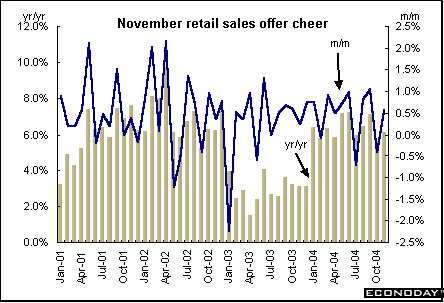
Asia
Japan - Fourth quarter Tankan large manufacturing index edged down to 22 points from 26 in the third quarter. The third quarter reading hit a 13-year high. The decline reflects concern among companies including Fujitsu and Toyota that earnings may be eroded by higher commodity prices and by the 5 percent gain in the yen against the dollar over the past three months. Small manufacturers' reading was unchanged at 5 points. Confidence among large retailers, banks, real estate firms and other non-manufacturers was unchanged in December at 11 points. The Tankan, which means short-term economic outlook, is the most closely watched index of business confidence. It surveyed 10,227 companies on the outlook for sales, profits and spending. Large companies are those with more than �1 billion in capital. The survey was conducted between November 10th and December 14th.
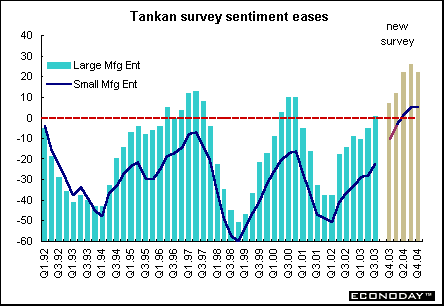
Americas
Canada - October merchandise trade surplus declined to C$4.4 billion. The level was C$3.0 billion lower than the most recent high of C$7.4 billion in June, which was the biggest surplus in three-and-a-half years. Exports sank 1.1 percent for a fourth consecutive monthly decline. The strong Canadian dollar and shipping congestion at Canadian ports were likely contributors to the lower export traffic. In contrast, imports were up 0.9 percent for their second increase in a row. They edged up primarily as the result of a 16.5 percent surge in imports of energy products. Canada's trade surplus with the United States narrowed from C$7.9 billion to C$7.6 billion. Exports to the U.S. dropped 1.6 percent while imports from the U.S. were down 0.7 percent. A C$240 million plunge in exports of Canadian forestry products to the U.S. accounted for the majority of October's overall decline. Exports to the European Union rose 4.4 percent, while those to other OECD countries went up 3.8 percent. Imports from non-U.S. destinations edged up 4.6 percent.
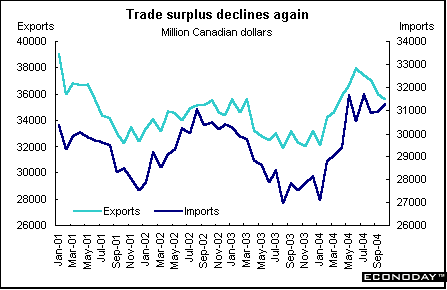
October manufacturing shipments declined 1.3 percent but are still 9.7 percent above October 2003. Major factors contributing to the reduced activity include the rising value of the Canadian dollar, which reached a 12-year high in late October, and the price of crude oil, which exceeded US$55 per barrel during the month. Prices for other raw material inputs have also increased substantially. Most industries (14 of 21) accounting for 71 percent of total shipments were down in October. The slowdown was concentrated in the durable goods sector, down 2 percent, with motor vehicles, down 7.1 percent, contributing the bulk of the decline. Nondurable shipments slid a more modest 0.4 percent. Shipments of chemical products fell 2.1 percent while paper manufacturing declined 2.1 percent. Unfilled orders were down 0.3 percent but are 3.1 percent above October 2003. New orders dropped 0.8 percent but are 11.5 percent above a year ago.
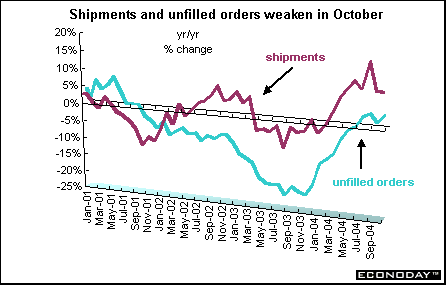
November consumer price index was up 0.4 percent and 2.4 percent when compared with last year. Higher prices for the purchase and leasing of cars and higher prices for fresh vegetables were the main factors in the increase. Core CPI, which excludes food and energy, was up 0.5 percent and 1.2 percent on the year. The Bank of Canada's core rate, which excludes eight of the most volatile index components, was up 0.5 percent and 1.6 percent on the year. Seasonally adjusted CPI was up 0.3 percent on the month.

Bottom line
With few economic indicators over the next two weeks, investors will be wrapping up their investment year and preparing for what 2005 may bring. Although there are two more weeks of trading in 2004, clearly few equity indexes followed here will match or exceed their exuberant double-digit 2003 gains. The all ordinaries should about double 2003's advance of 11 percent while the Bolsa should about equal their 40 plus percent growth again in 2004. But for the second year, all the change should be positive. On that note, I wish you a very happy and prosperous New Year!
Looking Ahead: December 20 through December 23, 2004
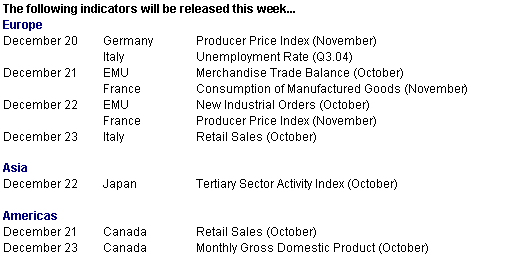
Looking Ahead: December 27 through December 31, 2004




